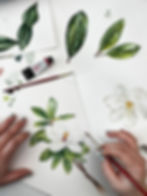Whenever I teach a live workshop, the same questions come up again and again. I get it! These are the kinds of things that can hold you back or leave you second-guessing yourself, especially when you’re just getting started.
So today I thought it would be helpful to answer five of the most-asked questions I get when I’m teaching.
And if I missed one of your top questions, write a comment and let me know! I often answer frequently asked questions in my email newsletter. So take a look at these top questions, pop yours in the comments, and make sure you're on my email list to get weekly watercolor inspiration and tips! (sign up here!)
Question 1: Is it okay for the pencil lines to show through?
Yes! I try to keep mine light by softening them with a kneaded eraser before I paint, but many artists actually embrace strong pencil lines as part of their style. Sometimes in lighter compositions, pencil marks actually help define your petals. Plus, pencil marks are one of those charming imperfections that make your painting look like it was made by an actual person!
✨ Tip: If you’re working on a larger piece, erase one section at a time. That way, your composition stays clear and you don’t forget where things go!

Question 2: Is it okay to trace?
Oh yeah! Drawing and painting are two different skills.
When you’re learning to paint, tracing helps you focus on watercolor techniques without worrying about proportions or shapes. It’s a tool, not a cheat.
I always encourage beginners to trace or use the traceables I provide.
Build confidence with the brush first, and you can always learn drawing later. 🎨 Here’s a beginner tutorial with a free traceable to get you started!
Question 3: I’m getting blobs in my brushstrokes…what am I doing wrong?
Honestly? It’s probably your paper. Low-quality paper doesn’t absorb or distribute water well, especially when you’re trying wet-into-wet techniques.
I think it’s really helpful to know that blotchy and blobby parts of your painting are often because of supplies and not because of a lack of technique or skill on your part.
My number one recommended supply is high-quality watercolor paper. Yup, it’s more expensive, but if you learn how to paint on bad paper, you’re going to have to re-learn all those techniques when you finally realize you are worthy and deserving of the good stuff! Here’s my favorite paper!

Question 4: Am I using too much water when I paint?
Probably! Water control is the name of the game when it comes to watercolors, and we need to control it on our brush, in our paints, and on our paper. Here are a few tips:
Start by always scraping your brush over the rim of your glass or jar. Do this every time you take your brush out until it becomes an automatic habit.
Work on understanding paint consistency. If you’re painting on dry paper, your paints should be more watery. If you’re painting into a wet area on your paper, you’ll want your paints to be thicker. Here’s a helpful YouTube video I posted about paint consistency!
Finally, control how much water is on your paper when you’re doing wet-into-wet. It should be enough to glisten, but not puddle or pool if you lift your paper up. It’ll take some time to get this right, and watercolor requires constant adjustment - that’s totally normal!!
Question 5: What size brush are you using?
This question is a frequent flyer! Here's the truth: using the exact same brushes as I use is just not important.
“So, Alex, what is important?” (I’m glad you asked!) 👇🏻
Does the brush hold plenty of paint?
Does it feel comfortable to hold?
Is it leaving stray hairs behind? (Hint: it shouldn’t.)
Brush sizes are NOT consistent between brands, so if I’m using a size 6 in one brand, and you’re using a size 6 in a different brand? They’re going to be different sizes. (I know! It’s annoying!)
I am comfortable using a large brush even for small areas, but I couldn’t have done that when I first started painting.
When you’re starting out, just think in terms of having a range of brushes in small, medium, and large sizes rather than fixating on numbers. Try out different sizes and use what works for you.
If you want to grab some high-quality brushes with a great range of sizes, I'd recommend the Princeton Heritage series. They're my favorite brushes!

Did I answer one of your questions? If not, drop yours in the comments below. I’ll start compiling a list of the most-asked questions and will answer them in my email newsletter.
Make sure you sign up for the email list here to see when your question is answered!










I think it would be awesome if you had your own QOR basic paint set with your favorite colors. I a. Slowly getting throw the foundation classes. Life keeps getting in the way. Thanks for all you do for us.